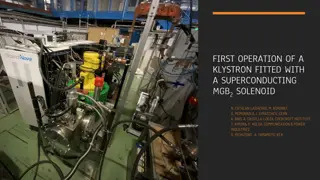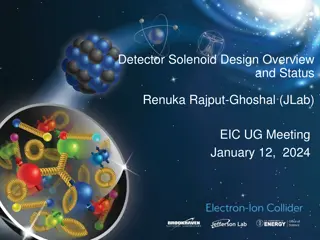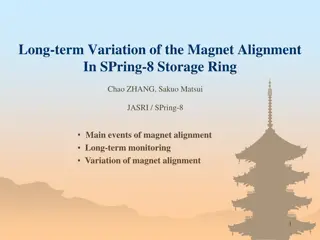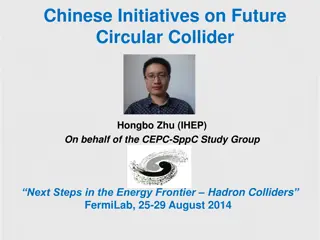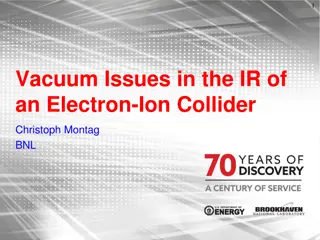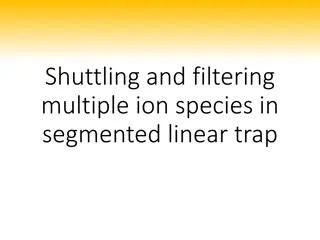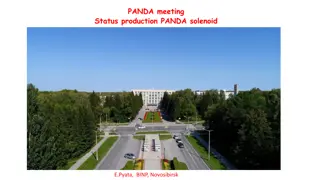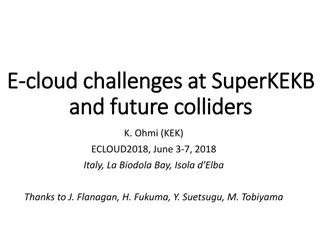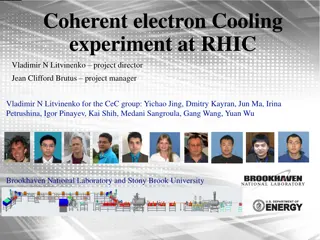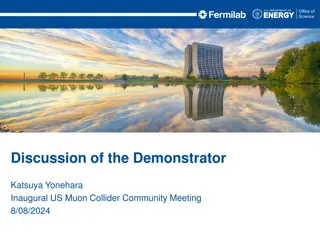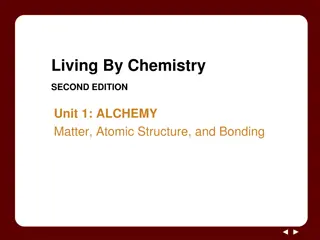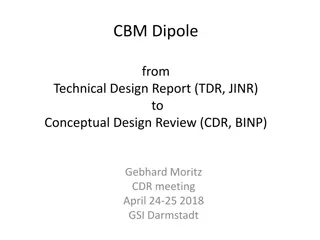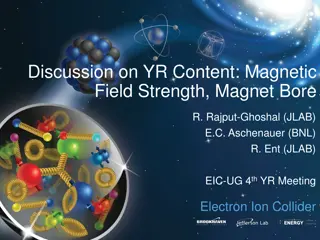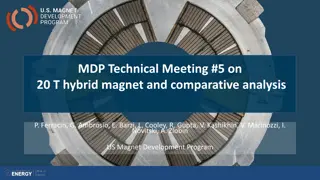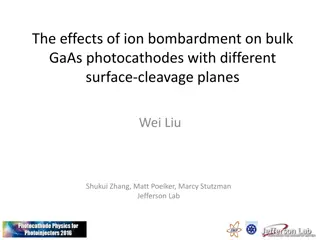Update on MARCO Solenoid Magnet Design for Electron-Ion Collider User Group Meeting 2023
Valerio Calvelli from CEA Paris-Saclay presented the status of the MARCO Solenoid magnet for the Electron-Ion Collider User Group Meeting 2023. The presentation covered an overview of the detector solenoid, magnet specifications, design status, cold mass details, and interaction length limits, providing insights into the progress achieved and upcoming milestones.
Download Presentation

Please find below an Image/Link to download the presentation.
The content on the website is provided AS IS for your information and personal use only. It may not be sold, licensed, or shared on other websites without obtaining consent from the author.If you encounter any issues during the download, it is possible that the publisher has removed the file from their server.
You are allowed to download the files provided on this website for personal or commercial use, subject to the condition that they are used lawfully. All files are the property of their respective owners.
The content on the website is provided AS IS for your information and personal use only. It may not be sold, licensed, or shared on other websites without obtaining consent from the author.
E N D
Presentation Transcript
Electron-Ion Collider User Group Meeting 2023 Valerio Calvelli (CEA Paris-Saclay) On Behalf of EIC Detector Magnet team Status of MARCO Solenoid July 27, 2023
Outline ePIC Detector Solenoid (MARCO) Overview MARCO Magnet Specifications Status of the Design 3D Magnetic Design Results Conductor definition Mechanical Design Cryogenic Design Magnet Assembly Conclusions MAgnet with Renewed COils 2
ePIC Detector Solenoid (MARCO) Overview Superconducting Detector Solenoid 3.5 m long coil, 2.84 m room temperature bore diameter 2 T on-axis field Operating Temperature 4.5 K Conductor: Copper Cladded, Rutherford Cable made with NbTi superconducting strands 3
MARCO Magnet Specifications Parameter Value Comment Parameter Value Coil length B5300 (B @ Z= -5300 mm) 3512 mm < 10 G Stray field requirement is based on IR magnet location Warm bore diameter 2840 mm B7400 (B @ Z= 7400 mm) < 10 G Cryostat length < 3850 mm B3400 (B @ R= 3400 mm) < 10 G Cryostat outer diameter < 3540 mm B3400 Parameter Value Comment Central Field B0 2.0 T Lowest operating field 0.5 T B5300 B7400 12.5 % Field 100 cm around center 80 cm radius Uniformity in FFA Magnetic Field Properties < 0.1 (mrad@30GeV/c) < 10 T/A/mm From Z = 180 cm to 280 cm Projectivity in RICH Area 4
Status of the Design MAGNETIC Design COMPLETED CONDUCTOR Design COMPLETED MECHANICAL Design FINALIZING CRYOGENICS Design FINALIZING DEFAULT SCENARIO FINALIZING DRAWINGS FINALIZING We are on schedule for the DOE Review in Nov. 2023 5
Status of the Design He Phase separator Service Tower Thermosyphon mandrel cryostat Yoke + Calorimeters 6
Magnet Design Cold Mass r cryostat 3850 Hadron Lepton MOD 3 MOD 2 MOD 1 IP z 30.0 32.7 100 offset 3 modules 6 layers 1668 turn Cold mass average thickness = 63.7 mm 7
Interaction Length Limits NbTi Rutherford Cable Pure aluminium Doped aluminium Aluminium alloy TRANSPARENCY for the transverse momentum Mean range No existing extrusion line in the world ? = 1/? ? ?? ? ? = ??/?? ??/? (Bethe equation) Stabilizer material for conductor Copper ?? Aluminium ?? ?= 4124?? ?= 1350?? ?3 Aluminum stabilized for detector magnet ?3 Conclusions from Workshop on Superconducting Detector Magnets @ CERN, 12/14 Sept 2022 3x less stopping power with the same coils dimensions and NbTi fraction in the cable if Aluminum is used We will not be able to use Aluminum stabilized conductors for long long time 8
Interaction Length Limits Thickness/Nuclear interaction length ATHENA SOCRATE Marco 1.5 T (4 layers) Marco 2T (6 layers) Material BaBAR 1.4 T Al 0.382 0.650 0.113 0.113 Cu 0.011 0.170 0.114 0.166 SS/Brass 0.000 0.417 0.136 0.181 NbTi 0.007 0.020 0.003 0.008 G10 0.009 0.028 Total 0.400 1.258 0.372 0.468 By R. Rajput-Ghoshal We can have a magnet working at 2T with essentially the same transparency as BaBAR 9 9
Magnetic Design Results Parameter V7.6.2.2.10 3D Units Current 3924 A # turns 1668 B0 2.000 T Homogeneity 12.7 % Projectivity 3.28 Tmm /A Bpeak (MOD 3) 2.671 T Energy 45.010 MJ Inductance 5.846 H Fz MOD 1 11.88 MN Fz MOD 2 57.5 kN Fz MOD 3 -11.97 MN Fz tot -32.4 kN Fr Tot 112 N B5300 15.3 G Fringe field will be compensated with local shielding around the focusing magnet B7200 10.9 G B3400 2.4 G 10
Conductor Design Parameters Values Units mm Strand diameter 0.7 Fiber Glass Insulation Cu/NbTi 1.3 20 =0.7 Strand R~0.3 A Ic @ 2.6T & 4.7K > 680 (2.31) 1.26 m Filament diameter < 30 5.12 RRR Cu > 80 6.78 4.6 NbTi strands 20 Copper Cable 11.4 mm Transposition pitch 50 Channel RRR Cu > 100 11.92 mm Copper section (Final) 43.7 Dimensions are in mm A Nominal current 3924 RRR conductor > 100 Order of conductor samples put in place based on these specifications First samples in October 2023 Contacting labs to test them K Temp. margin @ 2.6T & 4.7K 2.5 Conductor K Hot spot Temperature 71.4 MPa 0.2% @ 293K > 165 km Unit length 1.05 km Total length 18.9 11
Conductor Margins T helium = 4.55 K T cable 4.7 K DT = 0.15 K B0 1.5 T 1.7 T 2.0 T Units Current 2900 3296 3924 A Bpeak 1.925 2.187 2.602 T Temp. margin 3.1 2.9 2.5 K kJ/m3 Enthalpy margin 7.4 Load line margin 60.6 55.3 46.8 % I / Ic(Tm,Bpeak) 17.3 21.3 28.8 % 5000 Jc @ 4.7K Load line B0 = 2T B0 = 1.7T B0 = 1.5T 4500 4000 3500 Jc[A/mm2] 3000 2500 2000 1500 1000 500 0 CMS works at 1.8K of margin 0 1 2 3 4 5 6 7 8 9 Bpeak[T] 12
Mechanical Design Finalizing the detailed design Mandrel design completed Tie-rods finalizing 2D Model ready 3D Model finalizing MECH Design includes - Nominal CASE - How to transport the magnet - Tolerances 13
Magnetic Design 2D Results Coils made up of 6 layers of 93 turns of insulated conductors per module Each insulated conductor is composed of: Superconducting cable (in red) where magnetic forces are calculated for energization simulation Cu stabilizer (in green) Horizontal (in pink) and vertical (in blue) conductor insulation made of glass fiber 14
Magnetic Design 2D Results Deflection 50 Dr max = -5.89 mm Dz max (top) = -6.61 mm Peak Von Mises stress (MPa): Von Mises stress distribution in coils (MPa) Dz max (bottom) = 6.61 mm in coils = 55 < 133 in ground ins. = 53 < 198 in coil wedges = 84 < 198 in inter-module wedges = 54 < 198 in structure = 105 < 345 Peak stress localized at the top side of the central coil Brass avoid separation btw coils and mandrel during cool-down 15
Magnetic Design 2D Results Peak Von Mises stress (MPa): in supercond. cable = 50 < 150 in Cu stabilizer = 55 < 133 in glass fiber ins. = 49 < 198 Peak Sigma RZ stress (MPa) in conductor insulation: 14 = 14 16
Bottom view Cryogenics Design Vacuum pumps to be mounthere Top view 2 thermosiphons (main + spare) Phase separator design finalizing Thermal screen design finalizing 17
Ramp-up / Ramp-down Parameter V7.6.2.2.10 Units Current 3924 A Inductance 5.846 H Ramp 1 A/s Power 3.642 W Eddy current -1015.32 A R mandrel(P/I ) 3.516 M mandrel 3.570 mH L mandrel* 2.346 H k 0.964 Magnet can be ramped-up/down to full field at 1 A/s 1h15 min Full 3D Thermal Analysis ongoing to know how long it takes to cool it down (estimated 8 days from room temperature) 18
Other On-going Activities Tolerances Monte Carlo simulation to study the effect of tolerances and the robustness of the design Protection Finalizing the QUENCH simulations Finalizing the protection circuits Expected hot-spot temperature < 100 K Sensors List completed Finalizing the positions FMEA Analysis Ongoing for all components Drawings Updated daily 19
Conclusions Superconducting Detector Solenoid 3.5 m long coil, 2.84 m room temperature bore diameter 2 T on-axis field Conductor sample in production Robust mechanical design Magnet design is full of redundancies to make it work for more than 30 years Working hard to deliver the design for the Final Review in Oct 5/6! 20
How we work Collaboration of Jefferson Lab, CEA Saclay and Brookhaven National Lab 30% Design done as in-kind contribution by CEA Saclay in collaboration with Jefferson Lab Magnet Group BNL provides subject matter expert information on infrastructure and integration 60% design done as contract with CEA Saclay augmented with Jefferson Lab work and further in-kind contributions of CEA Saclay 90% design work is in progress in collaboration with CEA Saclay Expectation is that vendor contract may follow similar pattern for vendor oversight. Further discussions ongoing on international engagement on magnet construction phase. October 5/6 Final Review 21


